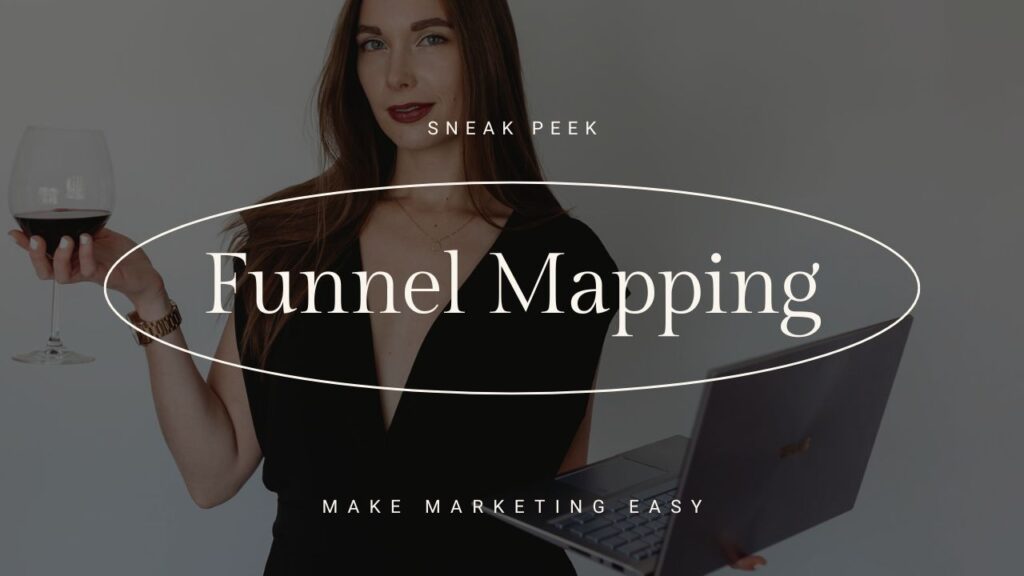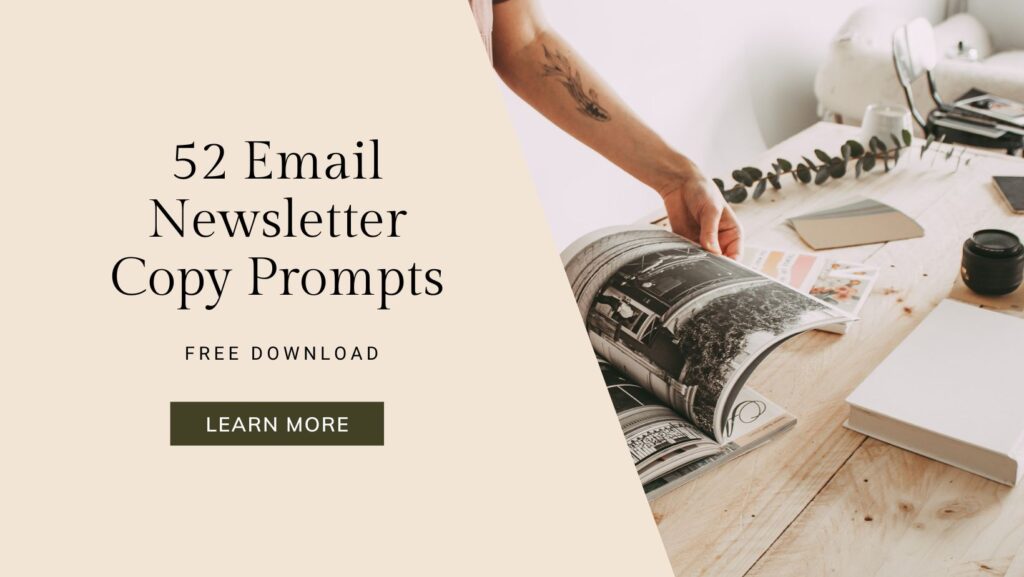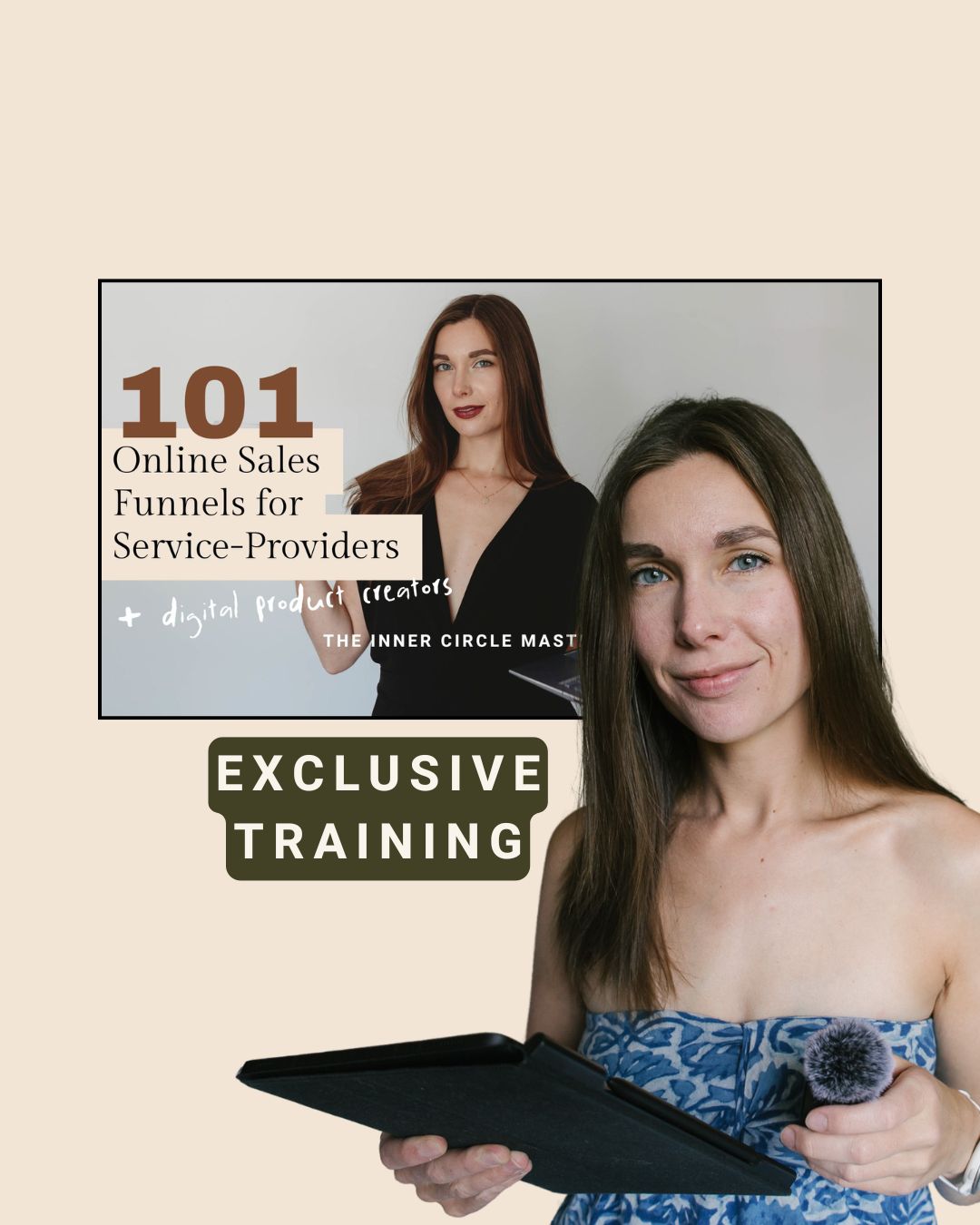How to Guide Buyers and Keep Them Coming Back
What’s an online sales funnel? And how do you use one to automate (or partially automate) your sales process as a service provider or digital product creator? I got you!
When you hear the word “funnel,” you might think of techy diagrams or marketing jargon. But at its core, a sales funnel is simply the journey someone takes from discovering your business to becoming a loyal, repeat customer.
In this post, I break down what a funnel really is and how you can use one intentionally whether you’re just getting started or looking to automate your offers.
I shared a video on YouTube that answers all these questions. It’s actually an exclusive training from inside my mastermind’s library of resources. I’m breaking all the rules today by letting you see this. But I really want to show you what it’s like in my virtual party. 💃 So now you can watch to get an introduction to sales funnels with examples of sales funnels you can try.
A sales funnel training to get on the same page
Inside my mastermind, clients get access to a dashboard filled with bite-sized training, templates, and resources. Little bits and pieces pulled from my business to answer their questions, help them work more effectively, and skip the messy figuring-it-out middle stage. Think of it like a backstage pass to my business. If someone asks a question, and I have a tool or more than a quick comment on the topic, you can bet there will be a new resource in the dashboard.
I treat my mastermind like 1:1 clients, curating the experience to meet the group’s needs.
This is why I love my mastermind so much—it’s the power of community, but a small enough group that I can curate the experience to meet people where they are. And this is why I call it a hybrid-style mastermind: Because there’s semi-structured learning, group coaching, and individual consulting.
In the most recent cohort, we jumped on a call to start mapping funnels together. All of that cohort either already have digital products and 1:many offers, or their 2025 goals include building an offer like this. But when I realized that not everyone had the same understanding of funnels, I put together a quick resource with an overview and examples to get everyone on the same page. That’s what this training is: An intro to sales funnels, so we can all start at the same level of understanding.
Lucky you getting to see this sneak peek.

What is a sales funnel, really?
A sales funnel in the most basic sense is just a flow that a lead follows to become a customer. In the online business world, the term “funnel” often refers to an automated or semi-automated sequence with offers presented at different stages of their sales journey.
When we talk about funnels, we’re really talking about how people buy—and more importantly, how they stick around. Your funnel is the path you create to guide people from first finding you, to buying, and eventually to staying and buying again.
It’s the path they take from the moment they find you to their first purchase, their second, and hopefully many more. It might start manually (like responding to DMs or hopping on a call), but over time, it becomes something you can streamline and automate.
Funnels aren’t exclusive to digital products. They apply to any business model:
- 1:1 services
- Group programs or masterminds
- Digital products
- Coaching or consulting
Some people call this a pipeline, and terms like “evergreen funnel” or “SLO funnel” (self-liquidating offer) are also popular types of funnels. But the concept applies to any type of business, online or offline. If someone moves through a process to work with you, that’s a funnel.
A sales funnel can be a powerful tool in your business that allows you to turn the taps on and off as your personal capacity allows.
A sales funnel removes the pressure for you to sell daily
A good sales funnel, especially when automated, will remove the pressure for you to show up on Instagram stories pitching your stuff every day. It allows you to step back because the inner workings of your business do the heavy lifting while you focus on 2 things:
- Filling the top of your funnel with good content, collaborations, or paid ads.
- Delivering on everything you sell.
Funnels help you:
- Focus your marketing efforts with intention.
- Create a smooth buyer experience for your clients
- Build systems that scale.
- And most importantly, increase customer lifetime value by serving your best-fit clients again and again.
Overall, a sales funnel provides clarity for you and your audience. By defining the customer journey, you make it easier for people to say yes at every stage, from first touch to forever fan.
Whether you’re guiding people manually at first or automating later, mapping out this journey is one of the best things you can do for long-term growth.
Sales funnel stages: TOF, MOF, BOF
A well-built funnel guides people from curiosity to conversion—and each stage of that journey requires a different kind of message.
Here’s how TOF (Top of Funnel), MOF (Middle of Funnel), and BOF (Bottom of Funnel) align with your buyer’s awareness—and what to say at each step to move them forward.
TOF: Attract + Spark Awareness
- Buyer Awareness: Unaware → Problem Aware
- Your Goal: Get on their radar and help them realize there’s a problem worth solving.
- Key Content:
- Free content (Reels, posts, podcast, YouTube)
- Lead magnets (checklists, quizzes, guides)
- SEO blog posts
- Paid ads promoting value-first content
This is where someone stumbles across your world and thinks, “Oh wow, that’s me.” Your job is to name the problem, offer insight, and create curiosity.
MOF: Nurture + Build Trust
- Buyer Awareness: Problem Aware → Solution Aware
- Your Goal: Show them you understand the problem and offer a real solution.
- Key Content:
- Email sequences
- Case studies + testimonials
- Mini offers (templates, audits, strategy calls)
- Webinars or behind-the-scenes walkthroughs
At MOF, your audience is evaluating: Is this the right person or product for me? This is your chance to nurture, educate, and guide without pressure.
BOF: Convert + Keep
- Buyer Awareness: Solution Aware → Most Aware → Ready to Buy
- Your Goal: Make the decision easy, low-risk, and time-sensitive.
- Key Content:
- Sales pages
- Consult calls or DMs
- Bonuses, urgency, or limited spots
- Upsells, bundles, retention offers
At this point, they’re almost ready—they just need confirmation and clarity. Your job is to make the “yes” feel obvious.
Want your funnel to actually convert? Focus less on “what platform” and more on what stage your audience is in—and how you can meet them there.
Understanding the Lifetime Customer Journey
Think of your funnel as a lifetime journey for your customer—not just a one-time sale.
Here’s how that might look:
- Discovery
They find your content—Instagram, podcast, blog, or referral—and check out your virtual party. If they like your vibe, they follow, subscribe, or join your list. - Low-Risk Entry
They test the waters by booking a consult, buying a mini offer, or downloading a freebie. This is their way of figuring out whether you’re the right fit. - Core Offer Purchase
Once they trust you, they say yes to a higher-level offer—done-for-you services, coaching, a VIP day, or a digital course. - Retention and Upsell
After working with you, they stay in your world. They join a membership, buy templates, rebook a package, or move into the next level of support.
This is where retention and long-term value come in. Loyal customers who’ve had a great experience will often want more. That’s not just a bonus—it’s a powerful growth strategy.
Sales funnel examples for different offer types
Let’s look at three common types of funnels you might already be using (even if you haven’t called them that yet):
1. Done-for-You Service Funnel
- Traffic source: Instagram, LinkedIn, referrals
- Step 1: Visit your services page
- Step 2: Submit a contact form or application
- Step 3: You get on a sales call
- Outcome:
- If they say yes, you book the project.
- If they say no, you offer a downsell (like a template or VIP day).
This funnel is common for copywriters, designers, and service providers. It doesn’t require complicated tech—but it does benefit from clarity and follow-up systems.
2. Opt-In Funnel for Services or Group Programs
- Traffic source: Organic search, Instagram, paid ads
- Step 1: Offer a freebie (like a checklist or guide)
- Step 2: Nurture with a welcome email sequence
- Step 3: Make an offer (e.g., done-for-you package, launch support)
- If they buy: Upsell them with a higher-tier offer or add-on service.
- If they don’t buy: Send them a targeted downsell sequence with a smaller offer.
This kind of funnel can move cold leads toward higher-ticket investments with more warmth and intentionality.
3. Digital Product Funnel (SLO / Evergreen Style)
- Traffic source: Paid ads, podcast guesting, blog SEO
- Step 1: Opt into a lead magnet
- Step 2: See a tripwire offer (limited-time low-cost product)
- Step 3: Enter a post-purchase upsell or down-sell sequence
This is a classic “self-liquidating offer” (SLO) funnel. It aims to fund your ad spend with a small product, grow your email list, and set the stage for future offers.
Don’t overcomplicate your sales funnel
Funnels don’t need to be fancy to be effective. You can start simple by answering the following questions…
- How do people find you?
- What do they need to trust you?
- What would help them take the next step?
Then build in automation as you go. You can partially automate at first and get more complex as you grow.
When you zoom out and map your lifetime customer journey, you stop chasing new leads constantly and start building sustainable growth—with loyal customers who stick around.
How to build a sales funnel
Start with the Lifetime Customer Journey
The smartest businesses don’t just think about the first sale—they think about the full lifetime customer journey. Here’s what that could look like:
- Discovering Your Brand
They find your “virtual party” (aka your brand), and if they like it, they follow you, subscribe to your list, or start watching from the sidelines to learn more about what you do. - Testing the Waters
They might purchase a small digital product, book a discovery call, or grab an audit. This is their way of getting a taste of your world before committing to something bigger. - Making a Bigger Investment
Once they’ve had a positive experience, they’re more likely to say yes to higher-ticket offers like one-on-one services, done-for-you packages, coaching, or a mastermind. - Sticking Around
The goal? They don’t just buy once. They stay. They come back. They want more of your support, more of your products, more of your expertise. This is where retention becomes your biggest asset.
Sales funnel software
There’s so many different types of sales funnel software out there. While overwhelming, this is a good thing! It means you’ll be able to find something that works for you.
Here’s some examples of what sales funnel software can do for you, and some links to check out. These are all from my own business.
When I only sold done-for-you services, my sales funnel was a combination of my website (Squarespace at the time) and Dubsado (my CRM at the time). It looked like this:
- Website > sales pages
- Contact form > Dubsado auto-reply
- Services guide and automated call booking
- Call—best fits got a proposal
- Proposal accepted and contract signed
- Automated onboarding
Now, my sales funnels are more complex and sell different offers. I have lead funnels with tripwires and self-liquidating offers. Some guide leads towards digital products, while others upsell 1:1 or DFY work.
With the complexity, my tech stack looks different. Now, my sales funnel software includes the following:
- Showit website
- ThriveCart checkouts, tripwires, order bumps, and upsells
- ActiveCampaign automated sales sequences and delivery flows
You can see my most up to date tech stack here.
Sales funnel marketing: how to fill your funnel
Once your sales funnel is built, it’s time to fill the top. That’s where sales funnel marketing comes in. It’s all about choosing strategic ways to drive traffic to the top of your funnel (TOF) and guide them toward a purchase.
Here are three of the most effective ways to fill your funnel:
1. Paid Ads
Fast, scalable, and highly targeted—ads on platforms like Meta (Facebook/Instagram), Google, or Pinterest can send leads directly to your opt-ins, tripwires, or sales pages. Paid ads work especially well when your funnel is already converting.
2. Organic Content
This includes blog posts, podcasts, social media, YouTube, SEO, and email marketing. Organic takes longer to build but builds deeper trust—and your content keeps working for you over time.
3. Collaborations
Partnering with others—guest podcasting, email swaps, affiliate promotions, or bundles—can introduce your funnel to new, aligned audiences without spending on ads.
Each method can work on its own, but the magic often happens when you layer them together. Use paid for growth, organic for depth, and collaborations for momentum.
For the DIYers who don’t want to do their sales funnel alone…
If you’re like f*ck yes, this is the year I grow an email list, make a lead magnet, and start sending weekly emails… But you don’t really know where to start, I got you!!! 👇
✨ Get access to Billie the Messaging Maven, my AI strategist. She’s trained to guide you through my strategic messaging workshop, real-time, to draft your personalized messaging playbook. With this document, your copy will work better because you’ll finally know what to say. You can even feed the completed playbook to your ChatGPT, so it writes more effective copy for you too.
✨ Check out the Opt-In Friendly Email Templates in The Biz Bar to get immediate access to some of my favourite email marketing templates. This pack includes an opt-in page template based on the exact structure I’ve used with success for years.
✨ Download my free Anti-Burnout CEO Schedule for inspiration of what your weeks could look like too.
✨ Get 52 Newsletter Copy Prompts for free to write more interesting emails every week. Engage subscribers and build a community, not just a list.

Related
Leave a Reply Cancel reply
Leave your info below to join. You'll be added to my email list, but can opt out at any time.
